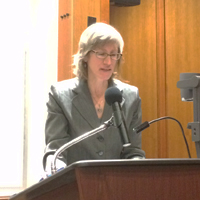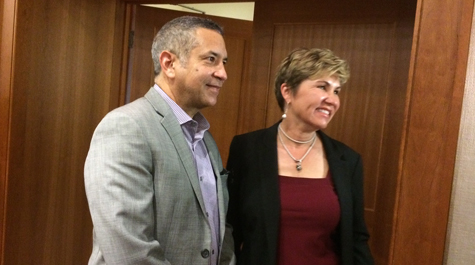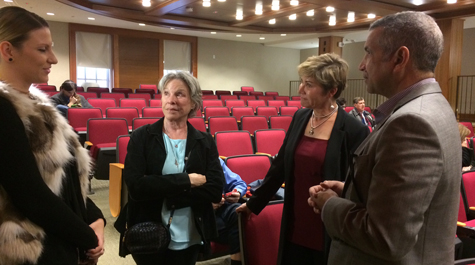'Sarajevo Roses' blossoms in U.S. debut at W&M
Two-time Pulitzer Prize nominee Roger M. Richards introduced the United States premiere of his documentary “Sarajevo Roses: A Cinematic Essay” on Feb. 21 with a thought-provoking experiment. He asked the audience at William & Mary’s Tucker Hall theatre to imagine waking up to find society collapsed: stores closed, electricity shut off, neighbors become enemies.
This was the world Richards witnessed as a photojournalist during the 1992-1996 siege of Sarajevo. Reporting from the Bosnian city at the height of the siege, he felt compelled to share its residents’ stories. Richards spent the next 24 years making “Sarajevo Roses” and insisted, “This can happen anywhere. It’s a human story, not a story of a stranger.”
Synchronicity brought “Sarajevo Roses” to Williamsburg. When Richards learned of William & Mary’s Bosnia Project, he decided it would be the film’s first stop on its tour of U.S. colleges. He was joined at William & Mary by executive producer Peggy Meder and associate producer Harry Brown, who interacted with audience members before and after the event.
Financial support for the screening came from many sources: W&M’s Bosnia Project, the Reves Center for International Studies, Russian and post-Soviet studies, the Roy R. Charles Center for Academic Excellence and the Institute for the Theory and Practice of International Relations.
Begun in 1999, the Bosnia Project is the university’s longest-running international service trip. Each summer a small group of undergraduates, after extensive study and mentorship under faculty advisor and Associate Professor of Government Paula Pickering, spend four weeks teaching children English and media skills in Sarajevo. The course culminates in the children producing their own short documentaries and fictional films.
William & Mary’s students work alongside education students from the University of Sarajevo. In the classroom, the co-teachers model as well as teach intercultural communication. Outside the classroom, the pairs often become close friends, providing each with a genuine window into the other’s culture.
The impact of “Sarajevo Roses” relies on the opportunity it offers for human connection. Rather than relying on explanatory or sensational voice-overs, Richards centered on five survivors of the siege. They recounted their lives during the war and their continuing struggles to recover in its aftermath, even though more than two decades have passed and three of them have made successful lives in countries other than Bosnia.
It was Richards’ intent that stark footage of burning skyscrapers, apartment blocks and suburban homes demand that the viewer recognize Sarajevo as a modern city no different than any in Western Europe or the U.S. Rather than focus primarily on the war itself, something he said many other films had done, he “wanted to tell the human side.”
In several scenes, small insets of war footage appeared on screen at the same time the film’s main characters were shown conversing with the “camera/audience.” Thus, Richards was able to bring their words to life.
Richards said he couldn’t presume to answer the questions his film asked, and there are many he said that still trouble him: How can modern civilization be so fragile? How is humanity capable of genocide? Can survivors ever be whole again?
When asked how the literary form of the essay informed the documentary, Richards pointed to its origin, “essay, from the French term meaning, ‘to attempt.’
“So an essay is an attempt,” he said.
“Sarajevo Roses,” Richards said, may not have answers, but there are many warnings. Even in societies as integrated as Bosnia’s, the characters he profiled said, politicians and propaganda can convince ordinary citizens to accept, condone and participate in genocide.
One of the subjects, a musician and psychiatrist named Asim Haracic, summarized that reality by saying, “Every human seems to have that small fascist in their head, and it would be very dangerous not to recognize that.”
Richards reinforced that notion by showing a plaque on the rebuilt Sarajevo City Hall that read: “Do Not Forget: Remember and Warn!”
It is a sentiment, Richards hoped, that his film would move people to do.

















